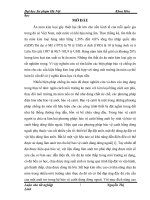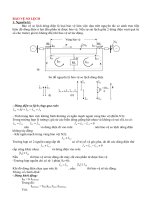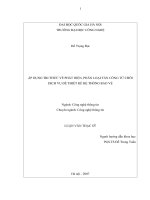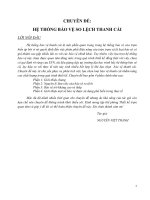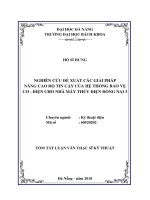Hệ thống bảo vệ Catot bằng dòng điện ngoài
Bạn đang xem bản rút gọn của tài liệu. Xem và tải ngay bản đầy đủ của tài liệu tại đây (1.05 MB, 16 trang )
Impressed current Cathodic Protection system
Design
• Impressed current cathodic protection systems (ICCP) are used to provide cathodic
protection for pipelines, ship hulls, offshore production platforms, water and
wastewater treatment equipment, tank farm and of course underground storage tanks.
• The principle advantage of ICCP is its much greater output capacity as compared to
galvanic anode systems. Therefore when protection is desired for large, poorly coated
and bare structures ICCP is often the choice.
• ICCP systems require external DC power source that is energized by standard AC
current.
•There are many anode materials available and most of them provide 100-10000 times
current provided by galvanic anodes.
•The amount of Metal exposed in UST’s is very large, so to inhibit corrosion, current
required is typically in excess of 4-8 amps per service station.
Advantages and Limitations
There are several advantages of using ICCP systems:
• Unlimited current output capacity: The amount of current can be designed
from few amperes to several 100 amperes. The amt of current will be a function of
no. of anodes provided, the rectifier voltage and amperage capacity and soil
(electrolyte) resistivity.
• Adjustable output capacity: The output of rectifier can easily be adjusted to
accommodate the changes in circuit resistance or current requirement. It can be
automatic or manually controllable.
• Low cost per ampere of CP system: Galvanic anodes are expensive where
amperes rather mill amperes are required.
The ICCP do have disadvantages as well, and can be listed as:
• They are most costly even if only a mill amperes of current is required. Their base
cost itself is several thousand dollars.
• ICCP have higher maintenance cost because they are prone to failure of switches,
fuses and need to be monitored frequently.
• ICCP may create stray current corrosion on other near by structures and it is
inherent potential problem of system. This can be minimized sometimes by
distributed anode designs where by anodes are placed near to protected structure.
Available Anode Materials
There are no. of anode materials used, which are selected depending on environment
and congestion. Like HSCI and Graphite anodes are used for Pipelines while Ti based
Precious metal oxide anodes are used in UST because of light wt and small diameter.
Canisters are filled with high conductivity
coal or calcined petroleum breeze.
Canisters are metallic spiral galvanized
ducts with dia of 3’’, 4’’, 6’’ etc. Package shd
be provided 2-3’’ bore.
The type and no. of anodes is dictated by user experience and current required for
protection of structure.
Jobs for Corrosion engineers include:
• Current requirement test: by installing temporary current anode bed of cu
electrodes and measuring the potential of structure with Cu-CuSO4 electrode versus
increase in current.
• Continuity: All metallic components that are to be protected must be electrically
continuous. Nearby foreign structures must also be made continuous to avert stray
corrosion effect.
• soil resistivity: Resistivity test is most essential to the design and are measured with
varying depths by 4 pin Resisitivity meter or two pin shepard canes device.
• Anode Location and Size: one method is to install anodes at depth of 10-20 feet in
augured holes with a spacing centre to centre of 10-30 feet with first anode being
placed 100 to 500 feet from the pipeline depending upon soil resistivity and structure
coating.
Continued……
•Another option is to distribute the anodes along the structure with each anode being
placed 10-20 feet from the structure. This is occasionally done on large diameter bare
pipelines while almost always done on UST’s.
•The anodes are generally distributed based on current requirement testing and
current requirement for each metallic component to be protected.
• All the resistance formulas mentioned in Galvanic protection system design
equally apply to Impressed current anodes. The tables provide below are based on
1000 ohm cm resistivity spaced between 10-20 feet. Incase ,If soil resistivity is 4500
ohm cm then multiply it by 4.5, because of linear relationship with resistance.
Anodes and Ground Lead wires
• The most common insulation for anode lead wires are High MW low density
polyethylene CP cable. Other cables for more arduous atmosphere are Halar, Kynar and
Hypalon insulations. The cu conductor is most commonly #8 AWG 7 strand annealed
copper.
• Use of individual wires has the double benefit, one is to eliminate splices and assuring
only one anode become inoperative if it got damaged.
• System ground wire: Ground wire should be from structure to negative terminal of
Rectifier and connection is done by thermite brazing directly to the metal.
Thermite brazing
Rectifier power supply
For selection of Power supply, these things are to be considered:
• DC output
• Capacity
• AC supply voltage
• In addition the method of control (manual/automatic), cabinetry, monitoring
devices etc must be clearly defined and selected.
• The control selection will depend on location of Test station. Far off places with
no frequent checkups will be monitored by remote methods while nearby places
are usually monitored by Manual controls.
• Some features which are suggested for underground operation are constant
current control and remote monitoring with the ability of requesting potential
readings from permanent reference electrodes.
Resistance of Prepackaged Anodes
Graphic Representation of Resistance for 3’’ canister
Graphic Representation of Resistance for 4 and 6’’ canister
Useful Data for Protection of Steel in Various environment
Potential required for cathodic protection
Metal
Steel
Steel (sulphate reducing bacteria)
Copper alloys
Lead
Aluminium
Potential
(Cu/CuSO4)
-850 mV
-950 mV
-500 to –650 mV
-600 mV
-950 to –1200 mV
Current densities
Current densities required to protect steel
Environment
Acidic solutions
Saline solutions
Sea water
Saline mud
Current density
A m-2
350 – 500
0.3 – 10
0.05 – 0.15
0.025 – 0.05
Average resistivity's of some soils
Environment
Brackish river water
Sea water
Town supply water
Alluvial soils
Clays
Gravel
Sand
Resistivity (ohm cm)
1
25
1000 – 1200
1000 – 2000
1000 – 5000
10000 – 25000
25000 – 50000

